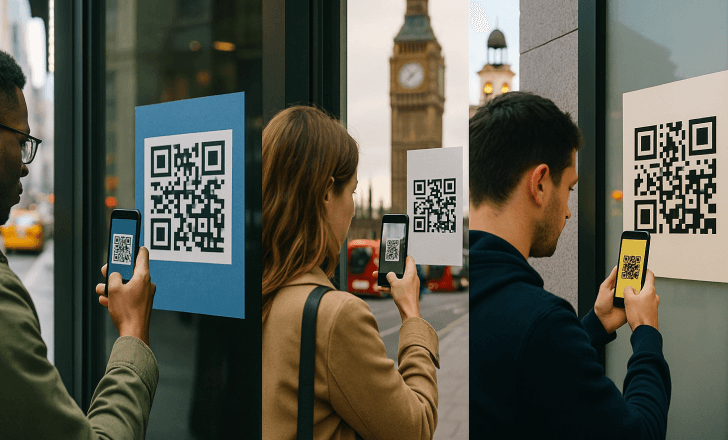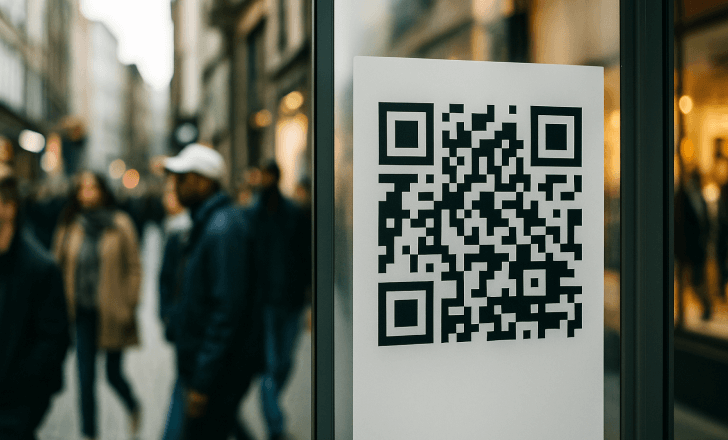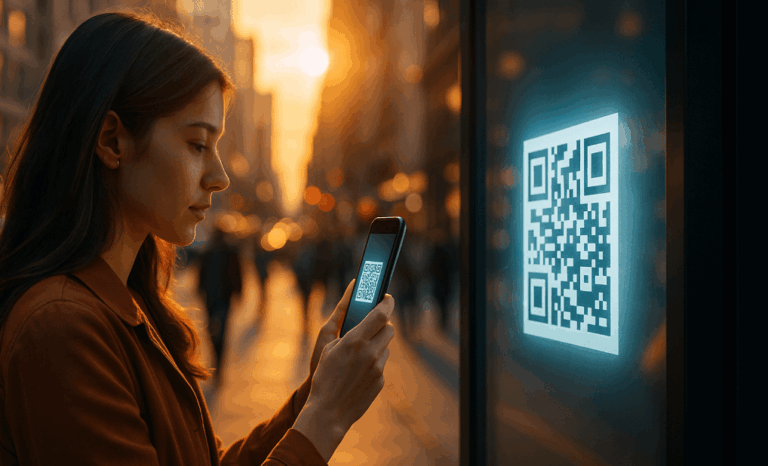In a world where marketing personalization is no longer optional, multi-url QR codes for geotargeting are becoming a game-changer for brands that want to deliver the right message to the right person at the right time. These aren’t the static black-and-white squares from the early 2010s. They’re dynamic QR codes—flexible, trackable, and smart enough to change destinations based on the user’s location, device type, or even browser language.
For marketers and businesses, this means one QR code can serve multiple audiences across countries, cities, or even specific neighborhoods—without having to reprint campaigns or manage countless variations. Let’s explore what makes this technology so powerful, how to create it, and the strategies that make it work.
From static to smart: Why geotargeting changes the QR code game
Static QR codes are simple: they contain a fixed URL that never changes. If you print one on a poster, it will always lead to the same web page—forever. That’s fine for basic use cases, but it’s not enough for modern marketing campaigns that demand flexibility and personalization.
Dynamic QR codes work differently. Instead of holding a fixed link, they point to a short, editable URL hosted on a dynamic QR code generator like QRCodeKIT. This means you can edit QR codes anytime without changing the printed code. You can also set rules to redirect users to different destination URLs depending on their geo targeting location, device type, or other factors.
With multi-url QR codes for geotargeting, you can:
- Send US users to one landing page, UK users to another, and Spanish speakers to a localized version.
- Direct people in a specific city to an in-store promotion while sending others to your e-commerce site.
- Run global campaigns using one QR code instead of printing multiple QR codes for each market.
This flexibility is at the heart of smart QR codes—and it’s why they’re replacing older static codes in serious marketing strategies.

How multi-url QR codes work behind the scenes
When someone scans a multi-url QR code, the process feels instant to them, but there’s a lot happening in the background. First, the scan is recorded by the platform’s analytics dashboard, capturing key metrics like device type, browser language, location, and time of scan. Then, based on the rules you’ve set, the system decides which specific landing page to send them to.
For example:
- If the scan comes from France, the user is redirected to your French e-commerce site.
- If it comes from Canada, the system checks the browser language—French speakers see one page, English speakers another.
- If the scan is from a location within 1 km of your store, the code can show a store-specific coupon instead of the generic page.
All this happens in milliseconds, thanks to dynamic code generation and server-side logic built into platforms like QRCodeKIT.

Why marketers love geotargeted QR codes
The beauty of multi-url QR codes for geotargeting is that they merge offline and online marketing into a seamless experience. By customizing where each scan goes, you can:
- Increase conversion rates – People are more likely to act when the offer or content is relevant to their location.
- Run localized campaigns at scale – Launch one campaign for multiple regions without juggling hundreds of codes.
- Improve customer engagement – Offer local deals, language-specific content, or event-based promotions that feel personal.
- Refine marketing strategies with robust analytics – Learn which regions scan the most, which content performs better, and where to focus future campaigns.
And because everything is editable, you can react to real-time trends, competitor moves, or supply chain changes—without reprinting a single flyer.
Creating dynamic QR codes with geotargeting
To set up a campaign, you’ll need a dynamic QR code generator with advanced features like geotargeting and advanced analytics. QRCodeKIT, for example, allows you to generate QR codes that redirect based on geo targeting rules, device type, and more. The process is straightforward:
- Create QR codes in your dashboard and choose the “multi-URL” or geotargeting option.
- Add your destination URLs for each target region or condition.
- Configure rules such as country, city, browser language, or GPS coordinates.
- Test your code to ensure each location gets the correct result.
- Print or share the QR code as part of your marketing campaigns.
Platforms like QRCodeKIT also integrate with Google Analytics and other marketing platforms for deeper tracking capabilities. This means you can follow not just scan numbers, but also on-page behavior after the click.

Multi-url QR code strategies that work
The real magic comes from combining multi-url QR codes for geotargeting with smart campaign planning. Here are some examples:
- Retail events: One QR code on posters in all your stores can lead to local event details for each city.
- Product packaging: Use one code worldwide, but show localized usage guides, recipes, or warranty details based on where the scan happens.
- Tourism: Place QR codes at landmarks that serve different language versions of the same guide.
- Seasonal promotions: Switch out landing pages to match local holidays, even if the printed materials stay the same.
By monitoring the qr code data and tracking features in real time, you can adapt marketing strategies to maximize impact.
Tracking and analytics: Turning scans into insights
A key advantage of dynamic QR technology is the ability to see how your campaign is performing. Basic analytics can show the number of scans over time, but robust analytics go much further, breaking down data by:
- Location
- Device type
- Operating system
- Time of day
- User behavior after scanning
With QRCodeKIT’s analytics dashboard, you can see which locations generate the most scans, which landing pages keep visitors engaged, and whether mobile users behave differently from desktop users. These insights make it easier to justify budget allocation, prove ROI, and fine-tune your marketing campaigns.

Choosing the best QR code generator for geotargeting
Not all platforms support multi-URL redirects or advanced tracking. When comparing options, look for:
- Dynamic code generation with multi-URL support
- Easy editing of existing QR codes without reprinting
- Custom domains for branding
- Integration with marketing platforms and API integrations
- Password protection for sensitive content
- Advanced analytics beyond basic tracking features
- Reliability to ensure your QR codes work 24/7
While some tools like QR Code Monkey or QR Tiger offer basic free options, advanced geo targeting and tracking capabilities usually require a paid plan. QRCodeKIT offers a free plan so you can test these features before committing.
Avoiding common mistakes with multi-url QR codes
Marketers new to geotargeted codes sometimes fall into traps that limit effectiveness. Common pitfalls include:
- Not testing all location rules before launch, leading to wrong page redirects.
- Using static QR codes for campaigns that require flexibility.
- Forgetting to update URLs when promotions expire, creating a dead end for the user.
- Neglecting qr code tracking, missing valuable performance insights.
Always remember: a QR code is just the starting point. The experience after the scan determines whether the user converts or bounces.

The future of geotargeted QR campaigns
As consumers expect more personalized interactions, multi-url QR codes for geotargeting will become standard in marketing strategies. Combined with AI-driven user behavior predictions and real-time analytics capabilities, brands will be able to run multiple campaigns through a single QR code, adjusting content instantly based on data.
Emerging features like hyperlocal targeting (down to specific store aisles), weather-based content changes, and integration with smart QR IoT devices will make these codes even more powerful.
Why QRCodeKIT is the ideal platform for multi-url QR codes
With QRCodeKIT, you can create dynamic QR codes that adapt to each user’s location, track performance with advanced analytics, and edit destinations at any time. You can also apply custom branding, integrate with your marketing platforms, and manage multiple campaigns from a single dashboard.
Whether you’re launching a global product, running localized events, or creating multilingual content experiences, QRCodeKIT’s advanced features give you the flexibility and control to make every scan count. From code creation to tracking and optimization, it’s a complete solution for marketers who want to maximize the potential of multi-url QR codes for geotargeting.
Final thoughts
If you want to bridge the gap between offline and online marketing while delivering a tailored experience to every user, multi-url QR codes for geotargeting are the way forward. They reduce printing costs, simplify qr code creation, and allow for rapid content updates—all while providing detailed analytics to refine your approach.
With a dynamic QR code generator like QRCodeKIT, you can turn a single printed square into a personalized gateway for every customer, anywhere in the world.
